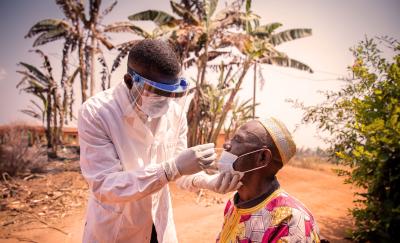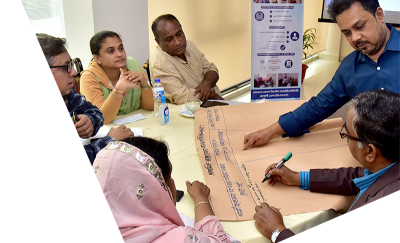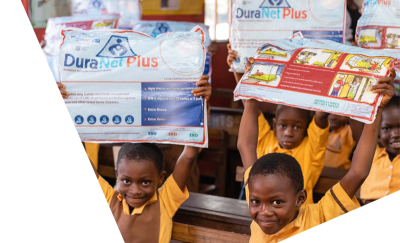Getting to 95+: Culture of Learning, Data-Use Drives Demand for HIV Services in Mozambique




Mozambique has the eighth highest HIV prevalence in the world—12.6 percent of the adult population is living with HIV, according to UNAIDS—and it remains a leading cause of death, despite improvements in recent years.
When it launched in late 2019, the USAID-funded Efficiencies for Clinical HIV Outcomes (ECHO) project was tasked with an ambitious mandate to accelerate progress and reach 95-95-95 targets, meaning: 95 percent of people living with HIV know their status, 95 percent of those are receiving treatment, and 95 percent of those are virally suppressed.
Nature wasn’t on our side. A few months in, COVID-19 hit, shuttering clinics. This was after a close succession of major cyclones and floods—all shocks to Mozambique’s health system and the population.
But not only is ECHO set to achieve and surpass many of its 5-year targets—only 2.5 years into the project—almost twice as many people are now on treatment from 190,477 in Oct 2019 at the start of the project to 353,498 today (an 85 percent increase). ECHO has already achieved more progress since 2019 than other implementing partners did in 10 years of programming prior.
To date, Abt has helped over 3.1 million people learn their HIV status across our four target provinces in Mozambique. In these regions, PEPFAR set a goal to diagnose just under 90,000 positive cases. The ECHO project alone, one of many PEPFAR implementing partners, is responsible for 41,119 of those positive case identifications to date.
We have also seen progress in linkages to care—at 96 percent in the four provinces, from 70 in November 2019. And among those in treatment, viral suppression is 91 percent, up from 78 before.
How did the program expand treatment, and ensure continuity for clients, while also reducing facility visits to limit exposure to COVID-19? Rigorous data collection and use, frequent analyses, a culture of learning, and a healthy spirit of competition in innovation are at the heart of ECHO’s success.
Working at both the community and health facility level, the local Abt team and partners collect a massive amount of data that guides our programming. As part of our approach, we invest in building local ownership of these data and contribute to developing the capacity of our partners, including the Ministry of Health, provincial health departments, and local community-based organizations, to make decisions and adapt data-driven strategies. With each province and community’s demographic makeup, geography, and history varying immensely, ECHO avoids one-size-fits-all approaches.


Both our partners and USAID agreed that there was a need for learning at all levels. So from ECHO’s inception, we embedded collaborating, learning, and adapting into the project’s organizational structure and implementation processes. In collaboration with the technical team, our dedicated integrated Innovation, Learning, and Adapting (ILA) team established learning systems that touch every aspect of our implementation.
Developing a culture of learning and informed decision-making starts at the top, and our commitment from day one of the ECHO project has cemented this into every aspect of our work.
We have done four important things that HIV programs anywhere in the world can replicate:
1. We built a decision-making foundation on the power of data analysis and visualization. Dashboards get data into the hands of program staff and enable indicator- and real-time facility-outcome tracking that is updated at the time of data collection, along with standard operating procedures and processes to ensure management and implementation respond appropriately to the challenges our data illuminate. We went through a rigorous cycle of planning, designing, and building dashboards while collecting user feedback at every stage. Using these dashboards at the central level, we can quickly identify whether labs or provinces are performing well or if they are lagging. If stocks for key HIV medicines are low, for example, we can quickly inform the Ministry of Health and direct logistical support to help the health facility fill the gap.
2. We prioritize data and hold trend reviews, without fail, every single week so that our provincial teams can learn from each other. Each week, leaders from each ECHO-supported province meet to look closely at project data trends. At these meetings, we learn about progress made on a weekly basis on initiatives to expand access to three-month supplies of drugs, HIV self-testing, pre-exposure prophylaxis preventive HIV treatment, and viral load tests. Weekly pause and reflect data meetings at the health facility, provincial, and project-wide levels, culminating in a presentation of topline results to USAID.
3. We incentivize data-focused problem solving through regular Innovation Fairs that encourage staff at all levels to create solutions to program-wide challenges. We also share these lessons learned and best practices so they can be replicated across the program. For example, one of our provinces noticed that men were being tested for HIV at a much lower rate than women. Our medical teams brainstormed and proposed more community-driven and locally relevant solutions to target men, get them tested, and enroll them in treatment if they test positive. When we started implementing their ideas, like going to popular male-dominated group settings, HIV positivity (and therefore testing) in one province spiked from one percent to four percent in just four months.
4. We test our approaches systematically through rapid cycle evaluations that identify root causes of success or gaps. These analyses generate evidence that inform our strategy and help us craft tailor-made approaches we can scale up program wide. By conducting a rapid cycle evaluation in response to high patient dropout rates—we were losing 32,059 patients per quarter at the start of the program—we were able to quickly pinpoint program weaknesses. We learned that up to 60% of patients were dropping out of treatment between their 6-month and 18-month milestones. Since we began targeting this group, patient loss plummeted to just under 5,000 patients. In the coming year, we will be testing the effectiveness of strategies such as distributing self-testing kits to underserved populations. This approach builds upon our routine analyses, zeroes in on precise gaps, and quickly identifies where we can move the needle.


These data-centric strategies allow the project to focus on challenging areas and launch new strategies. In two years, we dropped from 15 percent of patients lost to treatment follow-up to just one percent. Applied globally, ‘following the data’ can help us reach 95-95-95 targets sooner. What that means is the possibility of ending AIDS in a generation.
At their heart, these are localization, data science, and adaptation strategies. Innovation, collaboration, and learning are all building blocks for more resilient health systems—systems capable of seeing trends, designing solutions, and measuring their success to save and improve lives.
Read More
Health in Sub-Saharan Africa

Global Health Security: 2024 Year in Review
Abt Global’s top global health security insights from 2024 as we look ahead to 2025.

Health Systems Research (HSR) 2024
Abt Global is exhibiting and presenting at Health Systems Research (HSR) in Nagasaki, Japan in November 2024.

The 2024 Annual Meeting of the American Society of Tropical Medicine & Hygiene (ASTMH)
Abt Global is presenting and exhibiting at the 2024 Annual Meeting of the American Society of Tropical Medicine & Hygiene (ASTMH).

The 29th Conference of the Parties to the United Nations Framework Convention on Climate Change (COP29)
Abt will join governments, the private sector, and civil society at the 29th Conference of the Parties to the United Nations Framework Convention on Climate Change (COP29) this November to accelerate climate action.